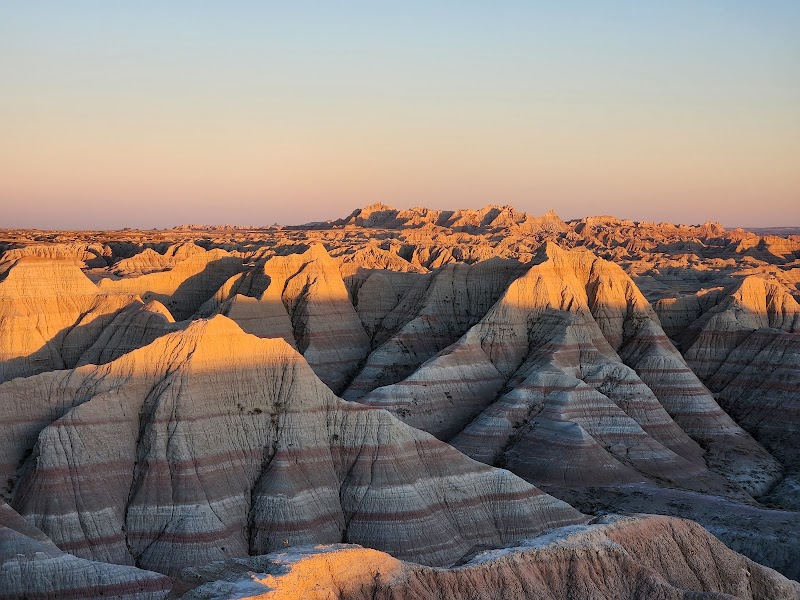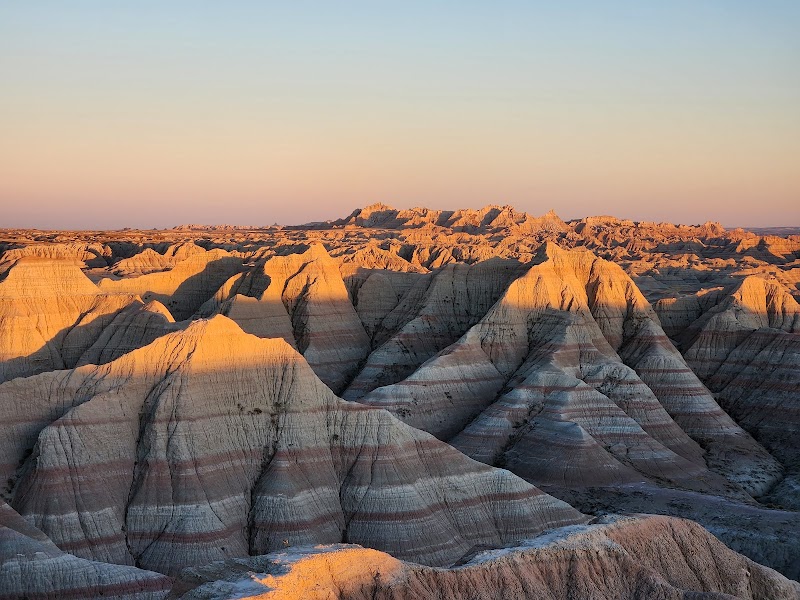Envision an awe-inspiring 244,000-acre canvas of layered rock formations, deep ravines, and towering pinnacles — a breathtaking landscape shaped by the artistic hand of nature itself. Welcome to Badlands National Park, where over a million visitors each year are captivated by its dramatic beauty, rich wildlife, and ancient fossil beds. A place where the spirit of the American West survives, offering an extraordinary mix of natural beauty and historical intrigue.
To fully immerse yourself in the Badlands' vast wilderness, a comprehensive tourist map is your essential companion. With it, you can chart your route through the park's expansive terrain, ensuring you don't overlook any of its mesmerizing vistas. More than just a navigational tool, it's a key that decodes the park's secrets, allowing you to explore and unearth the wonders of the Badlands at your own pace, similar to the Arches National Park tourist map.
Booking.comUnleash the Hidden Gems of Badlands National Park
Embark on an extraordinary journey as you delve into the hidden marvels of Badlands National Park. From sprawling landscapes that extend beyond the horizon to the remnants of a rich and vibrant past, Badlands National Park is an adventurer's treasure chest waiting for your exploration, much like the Grand Canyon tourist map reveals its awe-inspiring vistas. Let's venture into the heart of the American West and uncover the unique experiences this place has to offer.
Unlock the Mysteries of the Geological Wonders
The towering pinnacles, layered rock formations, and deep ravines are a testament to the park's inherent beauty. Yet, there's more to these geological wonders than meets the eye. Each formation narrates a tale of Earth's past, encapsulating eons of geological history within their layers. Use a Canyonlands National Park tourist map to navigate your way through such captivating wonders.
Window Trail and Door Trail
Witness the awe-inspiring landscape through the 'windows' of the Window Trail. This short, accessible trail leads to a natural window in the rock, providing an unhindered panorama of the jagged terrain. Adjacent to the Window Trail is the Door Trail, a gateway to the rugged wilderness of the Badlands.
Discover the Historical Riches
The grandeur of Badlands National Park doesn't end with its geological marvels; it is a portal to the past. From ancient fossil beds to remnants of the homestead era, the park's rich history is embedded in its captivating landscape.
Ben Reifel Visitor Center
Begin your journey through history at the Ben Reifel Visitor Center, where the park's past comes alive. Here, you can explore fascinating exhibits that narrate the story of the park's formation and the life that once flourished here. It's a must-visit spot, especially for those eager to deepen their knowledge about the region's rich legacy.
The Wilderness Experience
The wilderness of Badlands National Park is a world unto itself. From the expansive prairies to the rugged badlands, each distinct ecosystem offers a unique adventure waiting to be explored. Experience the solitude of the wilderness, where you can reconnect with nature and lose yourself in the captivating beauty of the landscape.
Conata Basin Overlook
The Conata Basin Overlook presents a breathtaking view of the Badlands, where the prairies and badlands merge to create an awe-inspiring spectacle. This overlook offers an exclusive perspective of the park's diverse ecosystems, and is the perfect spot for capturing unforgettable moments of your journey.
FAQs
What is the best time to visit Badlands National Park?
Badlands National Park is a year-round destination, but the best time to visit depends on your preferred experiences. For mild temperatures and lesser crowds, consider visiting during the shoulder seasons of spring and fall.
What wildlife can I expect to see in Badlands National Park?
Expect to see a diverse range of wildlife in the park, from the bison grazing on the prairies to the bighorn sheep climbing the rocky cliffs. Spotting wildlife in their natural habitat is one of the most thrilling experiences in Badlands National Park.

Useful Information for Your Visit to Badlands National Park
Transportation and Mobility
Access to the park is easy by car, with Interstate 90 running parallel to its northern boundary. The Badlands Loop State Scenic Byway, a main park road, provides access to various viewpoints and trailheads. Free parking is available at all trailheads and viewpoints. If you prefer public transportation, Greyhound buses stop in nearby Wall, and Rapid City Regional Airport is only an hour's drive away.
Schedules and Prices
Badlands National Park is open 24 hours a day, throughout the year. However, the Ben Reifel Visitor Center operates from 8:00 am to 4:00 pm in winter, and until 7:00 pm in summer. The park entrance fee is $30 per vehicle or $15 per individual if you are entering by foot, bicycle, or motorcycle. This fee grants you a seven-day permit to the park. An annual pass is available for $55.
Safety Tips
Staying safe in Badlands National Park involves preparing for the elements and respecting the wildlife. Always carry plenty of water, especially during the hot summer months, and protect yourself from the sun with a hat and sunscreen. Hiking boots are recommended for the uneven terrain of the park. Never approach or feed the wildlife, and maintain a safe distance at all times. In case of a thunderstorm, seek shelter immediately and avoid high points or solitary trees.
Practical Recommendations
Visiting the park early in the morning or late in the afternoon will not only help you avoid the day's heat, but also provide the best light for photography. Always check the weather forecast before setting off for the day, as weather conditions can change rapidly. Cell phone service can be unreliable in the park, so it's advisable to download maps and other necessary information in advance.

Frequently Asked Questions about Badlands National Park
1. Are there any special events or programs held in Badlands National Park?
The park regularly hosts unique programs like guided hikes, night sky viewings, and fossil talks. Always check the official Badlands National Park website for the latest schedules and details. These enriching experiences can provide an even deeper understanding of the park's remarkable geology and ecology, just as you would find in a Canyonlands National Park travel guide.
2. Is it possible to camp inside the park?
Yes, Badlands National Park offers two designated campgrounds: Cedar Pass Campground and Sage Creek Campground. Both provide a unique opportunity to sleep under the vast South Dakota sky. Note that amenities are limited, so come prepared. Camping reservations can be made online.
3. Are there any dining options inside the park?
The Cedar Pass Lodge, located near the Ben Reifel Visitor Center, has a full-service restaurant offering breakfast, lunch, and dinner. The adjacent gift shop also sells snacks and beverages. Keep in mind, dining options outside the park are limited, so plan your meals accordingly.
4. I'm a photographer. What are some recommended spots for capturing the park's beauty?
For photography enthusiasts, the park's Pinnacles Overlook, Yellow Mounds Overlook, and Bigfoot Pass provide breathtaking views especially at sunrise or sunset. Remember to respect the park's rules while capturing your shots. The park's majestic beauty offers endless opportunities for spectacular photography.
5. Can I bring my pet to the Badlands National Park?
Pets are permitted in Badlands National Park, but with restrictions. Pets must be kept on a leash no longer than six feet and are allowed only in developed areas like campgrounds and picnic areas. They are not permitted on trails or in wilderness areas to protect the park's wildlife.
6. What precautions should I take for the extreme weather conditions in the park?
Extreme weather conditions are common in Badlands National Park, with blistering summers and freezing winters. Always check the weather forecast before your visit and dress accordingly. Carry plenty of water, a hat, sunscreen, and sturdy hiking shoes in summer. In winter, wear warm clothing, thermal gloves, and sturdy boots.

